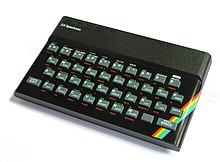
Back Sinclair ZX Spectrum ALS ZX Spectrum AN زد إكس سبكتروم Arabic زى اكس سپكتروم ARZ ZX Spectrum Byelorussian ZX Spectrum BE-X-OLD ZX Spectrum BS ZX Spectrum Catalan Sinclair ZX Spectrum Czech Спєктроумъ CU
 | |
 Issue 2 1982 model | |
| Developer | Sinclair Research |
|---|---|
| Type | Home computer |
| Generation | 8-bit |
| Release date | |
| Introductory price | UK: £125 (16 KB) (equivalent to £557 in 2023) / £175 (48 KB) (equivalent to £780 in 2023) ,[2] US: $200, ESP: Pta44,250 |
| Discontinued | 1992[3] |
| Units sold | 5 million[4] |
| Media | Compact Cassette, ZX Microdrive, 3-inch floppy disk on Spectrum +3 |
| Operating system | Sinclair BASIC |
| CPU | Z80A (or equivalent) @ 3.5 MHz |
| Memory | 16 KB / 48 KB / 128 KB (IEC: KiB) |
| Display | PAL RF modulator out 256 × 192, 15 colours |
| Graphics | ULA |
| Sound | Beeper, AY-3-8912 (128K models) |
| Predecessor | ZX81 |
| Successor | QL, Sinclair PC200 |
The ZX Spectrum (UK: /zɛd ɛks/) is an 8-bit home computer developed and marketed by Sinclair Research. One of the most influential computers ever made and one of the all-time bestselling British computers, with over five million units sold. It was released in the United Kingdom on 23 April 1982, and around the world in the following years, most notably in Europe, the United States, and Eastern Bloc countries.
The machine was designed by English entrepreneur and inventor Sir Clive Sinclair and his small team in Cambridge, and was manufactured in Dundee, Scotland by Timex Corporation.[5] It was made to be small, simple, and most importantly inexpensive, with as few components as possible. The addendum "Spectrum" was chosen to highlight the machine's colour display, which differed from the black-and-white display of its predecessor, the ZX81. Rick Dickinson designed its distinctive case, rainbow motif, and rubber keyboard. Video output is transmitted to a television set rather than a dedicated monitor, while application software is loaded and saved onto compact audio cassettes.
The ZX Spectrum was initially distributed by mail order, but after severe backlogs it was sold through High Street chains in the United Kingdom. It was released in the US as the Timex Sinclair 2068 in 1983, and in some parts of Europe as the Timex Computer 2048. Ultimately the Spectrum was released as seven models, ranging from the entry level with 16 KB RAM released in 1982 to the ZX Spectrum +3 with 128 KB RAM and built-in floppy disk drive in 1987. Throughout its life, the machine primarily competed with the Commodore 64, BBC Micro, Dragon 32, and the Amstrad CPC range. Over 24,000 software products were released for the ZX Spectrum.[1]
The Spectrum played a pivotal role in the early history of personal computing and video gaming, leaving a legacy that influenced generations. Its introduction led to a boom in companies producing software and hardware, the effects of which are still seen. It was among the first home computers aimed at a mainstream UK audience, with some crediting it for launching the British information technology industry. The Spectrum was Britain's top-selling computer until the Amstrad PCW surpassed it in the 1990s.[6][7][8] It was discontinued in 1992.
- ^ a b Lewis, Rhys (23 April 2016). "April 23, 1982: ZX Spectrum brings affordable — and colourful — computing into Britain's homes". London: British Telecom. Archived from the original on 30 April 2016. Retrieved 4 April 2021.
- ^ Leigh 2018, p. 69.
- ^ "How the Spectrum began a revolution". BBC. 23 April 2007. Archived from the original on 26 January 2021. Retrieved 4 April 2021.
- ^ Mott 2000, p. 76.
- ^ Cite error: The named reference
Daywas invoked but never defined (see the help page). - ^ Cellan-Jones, Rory (23 April 2012). "The Spectrum, the Pi - and the coding backlash". BBC News. Archived from the original on 9 July 2021. Retrieved 30 June 2021.
- ^ Moran, Joe (28 August 2015). "Typewriter, you're fired! How writers learned to love the computer". The Guardian. p. 20. Archived from the original on 6 September 2015.
- ^ Crookes, David (10 March 2016). "Fancy a Fresh Slice of Pi?". Micro Mart (1404). Dennis Publishing: 8–10, 12, 14, 16 – via the Internet Archive. ProQuest 1787168972.